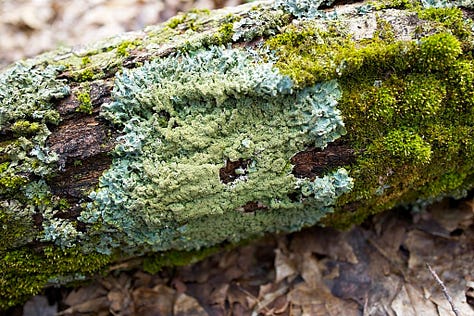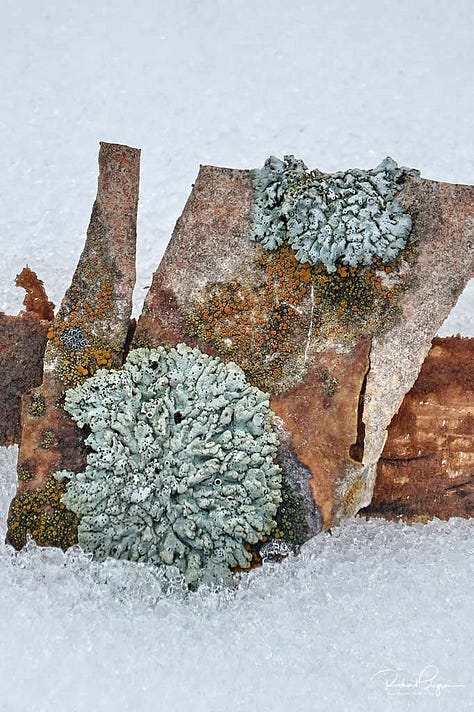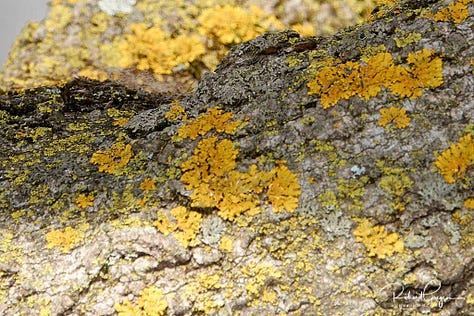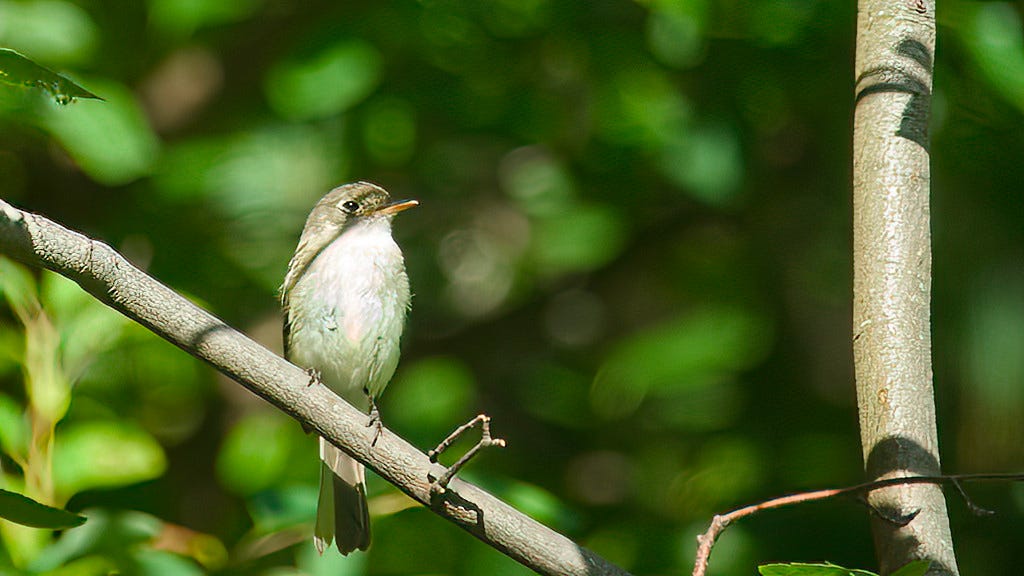Learn names.
Stop remarking on plants, birds and trees. Start learning their names. It’s hard work; it takes a long time. You’ll forget much along the way. But knowing just a few names will anchor your attention and sharpen your wits. Find ways to use those names and you’ll never lose them.
- “Enchantment” - Katherine May
It’s the start of March. Here in Montreal , winter is winding down with early snow-melt, though proper spring is still a few weeks in the future. Migration northwards has not started for birds, plants are all still dormant and, to be honest, nature in general is in the doldrums. So, not much all that inspirational to regale you with while I wait for the seasons to flip over. Consequently, I am going to talk a bit about my favourite place to encounter wildlife during most of the year. The Morgan Arboretum. Somewhere that we are very fortunate to have nearby, given that we live in the (outer) suburbs. The third string to my fiddle then … 1001 Species, some places they live and grow (that’s the new addition) along with news and ideas from a suburban wildlife garden
In the first week of April, 1998 - that’s 26 years ago - I had just arrived from England to work and live in Montreal. My new employers had provided me with a rental car while I got myself organised and I had my first weekend off to try get my bearings. It was cold and there was still some snow on the ground. A map in the hotel I was staying in showed an arboretum within a short drive and I decided that was a far better place to visit than endless shopping malls or the downtown area. I needed some trees and maybe a few birds. I am mentioning this because faithful readers will have noticed by now that an awful lot of the stuff I write about and take photos of happens in “The Arbo”. For a suburban area of a major city, this place is pretty unique. The Morgan Arboretum is a wildlife refuge and resource of immense value. From Baie-D’Urfé where I live, it is no more than ten minutes drive, 20-30 minutes by cycle and within walking distance if I am so minded. You can visit for an hour or a day or become a member and go any time you wish for as long as you like.
At which point let me share this illustrated link. All about modern ways of “Connecting to Nature” - click the link, it’s fun.
Over the past quarter century I have spent some serious time in the arboretum getting to know our wildlife. I have been chair of the arboretum’s “Friends” group and am on the board of the charity that manages some of what happens there, although it is actually owned by McGill university. I have done a lot of volunteering. Plenty of the species I encounter in the Arboretum spill over the boundaries and can also be seen in nearby gardens and along roadsides. Many cities have more green space than does Montreal, but few have anything so close to the city centre that is on this scale in which to wander and get close to the natural world. It may not be famous, indeed even in Montreal it is surprising how few people are aware of it, but it is more than extensive enough to lose yourself in for a day and never know that a major city lies just down the highway.
Created in 1945 on land made available to McGill University from the "back lots" of the Stoneycroft Farm, it was originally envisaged as a space that would be devoted to furthering knowledge of "forest development and woodlot management". Much has changed in seventy-plus years. The Arboretum is not only the largest green space on the island of Montreal but also the largest arboretum in Canada at some 245 hectares. Today it is a multi-use green space used by the university for environmental sciences research and teaching purposes, while at the same time providing a much valued space for the public to walk under the trees and enjoy a rare urban forest environment. Most importantly of all, it provides essential and increasingly rare habitat for the many animal and plant species that are still living amongst and around people in this splendid city.
The Arboretum does not stand in complete isolation. To the west are smaller, privately owned, wooded areas that together with the Arboretum comprise the Senneville Migratory Bird Sanctuary. To the east are diverse agricultural lands linking to the small Anse à l'Orme Nature Park and the somewhat larger Cap St-Jacques Nature Park alongside the river. Over the water from there is Ile Bizard which also has decent green areas and beyond that Ile Jésus (Laval). Taken together, these disparate areas form a linked green corridor that is essential to wildlife movement and survival; the Arboretum forming the largest single part.
Under the trees, there are some 25km of diverse trails, some relatively heavily used and others rather less so. Some short and some long, giving opportunities for everyone to find a trail to suit their needs. In the winter, two of the main trails are groomed for cross country skiing and a moderately long snowshoe trail also exists, while the "main" trail is accessible to walkers all year around.
Although the Arboretum is about flowers and trees it is also rich with birds and insects … In terms of birds there are 199 species recorded in the arboretum on eBird, and there 225 listed for the contiguous McGill Bird Observatory (not open to the public).
https://ebird.org/qc/hotspot/L247704
Turning to iNaturalist there are some 600 plant species that have been recorded and 369 species of insects and spiders
All of which is to say, that not all nature is far from human settlement - for this and I suggest for most, cities it is under our noses if we check out the records. I would be interested to know the species counts on eBird and iNaturalist for the locations readers of this newsletter happen to live. Check them out and let us know via the comments - it’s not a competition, by the way.
Not all we can encounter when wandering our neighbourhoods is colourful and charismatic. There are other interesting lives besides singing birds and gorgeous flowers. At this time of the year when all the trees are bare and rocks are not hidden by grasses, we can seek out … lichens. Easy stuff to find and damnably hard stuff to put a name to
Lichens
Lichens are not related to mosses or other plants or to fungi.. They are away in a separate kingdom of their own. The US Forest Service describes them as being “… a complex life form that is a symbiotic partnership of two separate organisms, a fungus and an alga. The dominant partner is the fungus, which gives the lichen the majority of its characteristics, from its thallus shape to its fruiting bodies.
You can see plenty of lichens hereabouts on tree bark and on stones. Generally they are more evident in the winter when they stand out visually although in that season they are just surviving. Some of the species I know we have are the following - noting that lichen identification is often difficult (to put it mildly) and specialist lichenologists have to take miniature chemistry sets into the environment to do tests on some of them to try to pin down their identities to species level.
In my part of the world you might look out for these common species for example - noting that some of my identifications are tentative … this really is specialist stuff.






The major component of a lichen is a fungus. The other component is photosynthetic and may be green algae or cyanobacteria (blue-green algae). Sometimes both. The non-fungal component can make food in the form of sugars while the fungus can kill or penetrate some of the algae cells to obtain food. Consequently… the symbiotic relationship is more correctly a controlled parasitism. It has been said that lichens are fungi that have taken up farming. They can live in many conditions and substrates that would deter other kinds of species and are pioneer organisms in ecological succession.
I happened upon this interesting article about subjects readers are looking to read about …
I checked back today, and the forum now has 1,255 comments. I dove in for another skim. Beyond that single request for facts about whales, only one other nature topic has materialized ... Assuming maybe 250 topics have now been proposed, I’d say — generously — that at most one percent of those were nature-related.
In other words … while we writers - there are a good few - who are working on nature related subjects that we think will interest people, not that many potential readers are actively seeking nature writing. Now, it’s true that many will nevertheless read such articles should they chance upon them but few are actively seeking them out.
I shall not be deterred!
I was pleased on reading and thinking about what this means to note that the author had written a list of links to “ … the writers whose posts I never skip, along with a piece of their writing that has stuck with me.” Blowing my own trumpet, she had included a link to a piece I wrote here in the new year 👍 Fortunately I do know how many readers have actively subscribed to my two newsletters and have fairly good metrics about numbers of readers so despite the above bucket of cold water I know you are out there, and I thank you for your interest.
Stop Press : Half an hour before “going to press” today, I found this link popping up over breakfast. Several good things in it but I was particularly struck by the maps of the medieval extent of the Celtic Rainforest in Britain. It is staggeringly unforgivable to see what has been destroyed and lost. Just think what it must have been like …













About naming - Learning names and applying them in your fielding has all the attention-developing and widening upsides the opening quotation extols. It can also seduce one into thinking the name (a marker on a language map) is the creature (the living or less lively thing in itself, and in all its changing relations through time and space, and in what it has to tell you from itself and in yourself). The complementary lore of forest bathing is to resist the urge to name and move on, and to be still and slow and observe and let yourself feel where you are, what you sense, and how you respond. Naming and not naming. Maybe it’s a tidal thing.
I will have to visit the Arboretum next time I am in Montreal. Sounds like a really interesting place for sure. Spring is giving us a nice preview here in Ottawa as well. The male Red-winged Blackbirds have begun showing up which is a great sign.